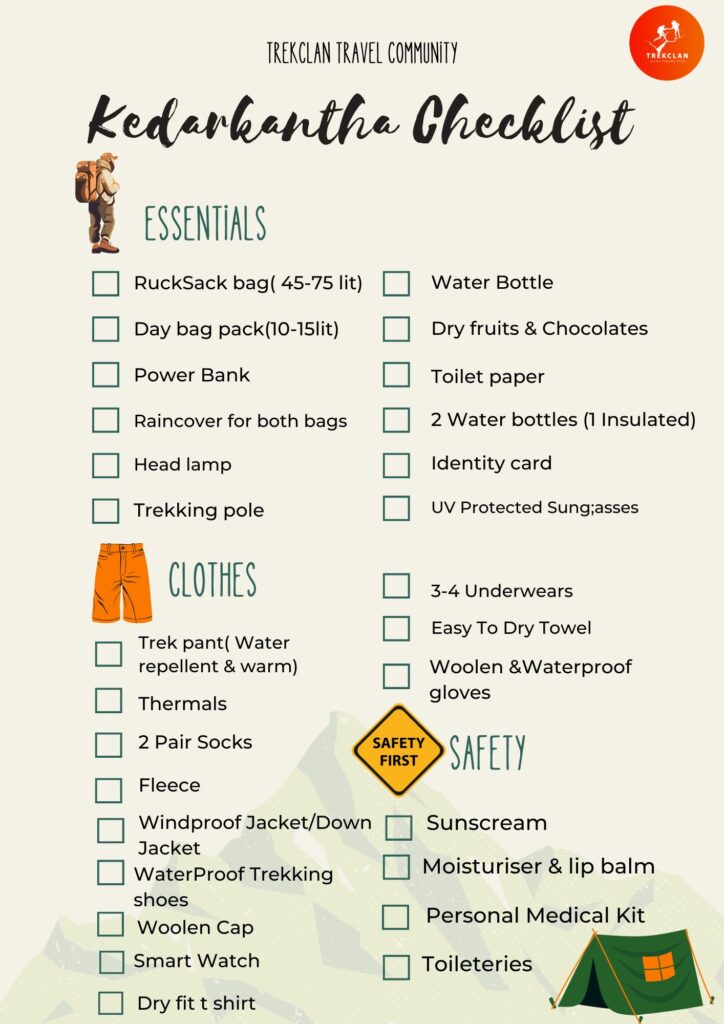
What to Carry?
The Kedarkantha Trek is one of the most popular winter treks in India, offering stunning views of snow-covered peaks and pristine landscapes. Located in the Uttarakhand Himalayas, this trek is perfect for adventure enthusiasts, but proper preparation is key to a successful and safe journey. Here’s a comprehensive guide on what to carry and how to prepare for the Kedarkantha Trek.
1. Clothing Essentials
Given the winter conditions and snow-capped trails, wearing the right clothing is vital for staying warm and comfortable throughout the trek.
- Thermal Weahttps://www.decathlon.in/p/8759460/skiing/men-thermal-for-skiing-bl500-blackr: Pack thermal tops and bottoms to keep your body heat intact during freezing temperatures.
- Insulated Jacket: A warm, insulated jacket is essential for protection against the cold. Down jackets or synthetic-insulated jackets are good options.
- Waterproof Pants: Snow and wet conditions require waterproof pants to keep you dry and comfortable.
- Trekking Shoes: A good pair of waterproof trekking boots is essential for tackling snow, ice, and muddy conditions. Make sure the boots are insulated to keep your feet warm, especially during the colder months. Look for boots with good ankle support to prevent injuries on uneven terrain.
- Gloves and Hat: Insulated gloves and a warm hat or balaclava are must-haves to protect your hands and head from the cold.
- Layering System: Use the layering system (base, mid, and outer layers) to adjust your clothing based on changing temperatures throughout the day.
2. Trekking Gear
The right gear is crucial for a safe and comfortable trekking experience. Here’s a list of what to carry:
- Backpack: A 40-50L backpack is ideal. Make sure it has a rain cover and is easy to carry over long distances.
- Trekking Poles: These help maintain balance on snowy and uneven terrain, preventing slips and falls.
- Sleeping Bag: Since temperatures drop significantly during the night, a four-season sleeping bag is necessary to stay warm.
- Headlamp: A headlamp or flashlight will be useful for navigating in the dark or setting up camp in the evening.
3. Health and Safety Essentials
Trekking at high altitudes and in snow requires extra caution, so it’s important to carry essential health and safety items:
- First Aid Kit: Pack basic items like band-aids, antiseptic wipes, painkillers, and any personal medications.
- Altitude Sickness Medication: Carry altitude sickness medicine like Diamox or consult your doctor for advice on preventing altitude sickness.
- Water Bottles and Hydration Pack: Stay hydrated to prevent altitude sickness. Carry a reusable water bottle and, if possible, a hydration pack for easy sipping during the trek.
- Snacks: Energy-boosting snacks like energy bars, dry fruits, and nuts will keep your energy levels high during the trek.
4. Mental and Physical Preparation
The Kedarkantha Trek is a moderate trek, but physical fitness is key for tackling the snow-covered and uneven trails.
- Physical Training: Engage in regular cardio exercises such as running, cycling, and brisk walking to build endurance. Strengthen your legs and core with exercises like squats, lunges, and planks.
- Mental Preparation: Mental toughness is just as important as physical fitness. Trekking in winter conditions, especially in snow, can be challenging. Prepare yourself for possible discomfort, fatigue, and unpredictable weather. Stay positive and focused.
- Acclimatization: At altitudes above 9,000 feet, altitude sickness can occur. To prevent it, ensure proper acclimatization by taking regular breaks, staying hydrated, and avoiding overexertion. Give your body time to adjust to the change in elevation.
5. Additional Tips
- Pack Light: While packing the essentials is important, avoid overpacking. A lighter backpack will make the trek more manageable.
- Trekking Guide: It’s advisable to trek with an experienced guide who knows the terrain and can help in case of emergencies.
- Weather Awareness: Keep an eye on weather forecasts and be ready for sudden changes in the weather, especially snowstorms or rainfall.
Conclusion
The Kedarkantha Trek is a once-in-a-lifetime experience that takes you through some of the most beautiful landscapes in the Himalayas. Proper preparation, both physical and mental, along with the right gear, will ensure a successful trek. By following this guide and carrying the essentials, you’ll be ready to take on this winter adventure and create unforgettable memories in the heart of the mountains.
